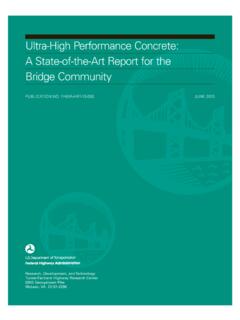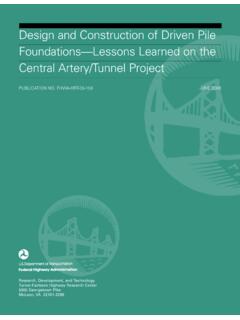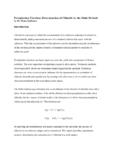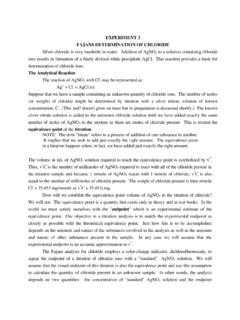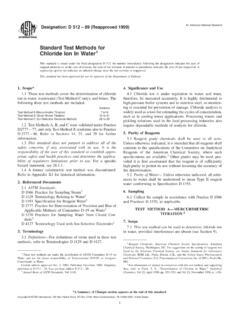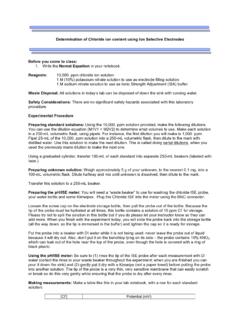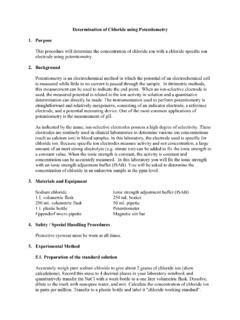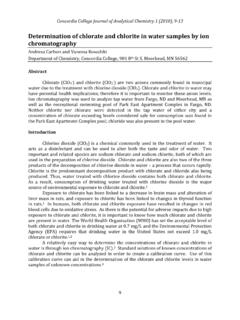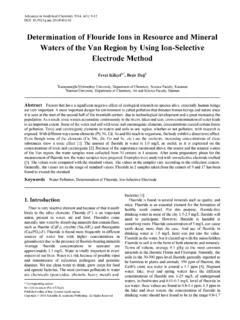Transcription of Testing Chloride Penetration Resistance of Concrete
1 FHWA Contract DTFH61-97-R-00022 Prediction of Chloride Penetration in Concrete Testing the Chloride Penetration Resistanceof Concrete : A Literature Stanish, Hooton and ThomasDepartment of Civil EngineeringUniversity of TorontoToronto, Ontario, CanadaTable of OBJECTIVES AND THEORETICAL Mechanisms of Chloride Ion Chloride Diffusion: A Brief Review of the Underlying Properties of the Concrete that Affect the Chloride Penetration EXISTING TEST AASHTO T259 (Salt Ponding Test) Bulk Diffusion Test (Nordtest NTBuild 443) AASHTO T277 (Rapid Chloride Permeability Test) Electrical Migration Rapid Migration Test (CTH Test) Resistivity Pressure Penetration Indirect Measurement Other Test REFERENCES24 APPENDIX: GLOSSARY OF TERMS RELATED TO Chloride Penetration AND TESTINGIN INTRODUCTIONR einforced Concrete structures are exposed to harsh environments yet are often expected to lastwith little or no repair or maintenance for long periods of time (often 100 years or more).
2 To do this, adurable structure needs to be produced. For reinforced Concrete bridges, one of the major forms ofenvironmental attack is Chloride ingress, which leads to corrosion of the reinforcing steel and asubsequent reduction in the strength, serviceability, and aesthetics of the structure. This may lead toearly repair or premature replacement of the structure. A common method of preventing suchdeterioration is to prevent chlorides from penetrating the structure to the level of the reinforcing steel barby using relatively impenetrable Concrete . The ability of Chloride ions to penetrate the Concrete mustthen be known for design as well as quality control purposes. The Penetration of the Concrete bychloride ions, however, is a slow process. It cannot be determined directly in a time frame that would beuseful as a quality control measure.
3 Therefore, in order to assess Chloride Penetration , a test methodthat accelerates the process is needed, to allow the determination of diffusion values in a OBJECTIVES AND SCOPE In this document, a review of the current common methods for determining Chloride penetrability ofconcrete is presented. First, some theoretical background of what influences the Penetration ofchlorides into Concrete is presented in Section 3. The different mechanisms of Chloride Penetration arepresented, followed by a further elaboration of the Chloride diffusion theory. The influence of basicproperties of Concrete on its Chloride penetrability is also discussed. In Section 4, individual testprocedures are presented. First, the existing long-term procedures are discussed, namely the saltponding (AASHTO T259) test and the Nordtest (NTBuild 443) bulk diffusion test.
4 The existing short-term tests are then presented. For each test, the procedure, the theoretical basis, and any advantagesand disadvantages are included in this document as an appendix is a glossary of some of the common terms related tochloride ingress Testing and THEORETICAL Mechanisms of Chloride Ion TransportCapillary absorption, hydrostatic pressure, and diffusion are the means by which Chloride ions canpenetrate Concrete . The most familiar method is diffusion, the movement of Chloride ions under aconcentration gradient. For this to occur, the Concrete must have a continuous liquid phase and theremust be a Chloride ion concentration second mechanism for Chloride ingress is permeation, driven by pressure gradients. If there is anapplied hydraulic head on one face of the Concrete and chlorides are present, they may permeate intothe Concrete .
5 A situation where a hydraulic head is maintained on a highway structure is rare, more common transport method is absorption. As a Concrete surface is exposed to theenvironment, it will undergo wetting and drying cycles. When water (possibly containing chlorides)encounters a dry surface, it will be drawn into the pore structure though capillary suction. Absorption isdriven by moisture gradients. Typically, the depth of drying is small, however, and this transportmechanism will not, by itself, bring chlorides to the level of the reinforcing steel unless the Concrete is ofextremely poor quality and the reinforcing steel is shallow. It does serve to quickly bring chlorides tosome depth in the Concrete and reduce the distance that they must diffuse to reach the rebar [Thomas,et al., 1995].Of the three transport mechanisms described above that can bring chlorides into the Concrete to thelevel of the rebar, the principal method is that of diffusion.
6 It is rare for a significant hydraulic head to beexerted on the structure, and the effect of absorption is typically limited to a shallow cover region. Inthe bulk of the Concrete , the pores remain saturated and Chloride ion movement is controlled byconcentration gradients. A fuller review of the theory of diffusion is presented in the following Chloride Diffusion: A Brief Review of the Underlying TheoryChloride diffusion into Concrete , like any diffusion process, is controlled by Fick s First Law, which,in the one-dimensional situation normally considered, states:JDdCdxeff= (1)where J is the flux of Chloride ions, Deff is the effective diffusion coefficient (see below), C is theconcentration of Chloride ions and x is a position variable. In practical terms, this equation is only usefulafter steady-state conditions have been reached, there is no change in concentration with time.
7 Itcan be used, however, to derive the relevant equation for non-steady conditions (when concentrationsare changing), often referred to as Fick s Second Law: CtDCxeff=22(2)which includes the effect of changing concentration with time (t). This has been solved using theboundary condition C(x =0, t >0) = C0 (the surface concentration is constant at C0), the initial condition C(x>0, t=0) = 0 (the initial concentration in the Concrete is 0) and the infinite point condition C(x = , t >0) = 0 (farenough away from the surface, the concentration will always be 0).3 The solution is:CxtCerfxDteff(,)014= (3)where erf(y) is the error function, a mathematical construct found in math tables or as a function incommon computer Concrete , there are some factors that interfere with simple interpretation of diffusion data. Firstof all, the Chloride ions are not diffusing through a homogeneous solution.
8 Concrete is a porous matrixthat has both solid and liquid components. The diffusion through the solid portion of the matrix isnegligible when compared to the rate of diffusion through the pore structure. The rate of diffusion is thuscontrolled not only by the diffusion coefficient through the pore solution but by the physicalcharacteristics of the capillary pore structure. This effect is normally considered implicitly, however, andthe effective diffusion coefficient of the chlorides into the Concrete as a whole is considered, called hereDeff. Other influences are discussed Properties of the Concrete that Affect the Chloride Penetration RateThe rate of ingress of chlorides into Concrete depends on the pore structure of the Concrete , whichis affected by factors including materials, construction practices, and penetrability ofconcrete is obviously related to the pore structure of the cement paste matrix.
9 This will be influenced bythe water-cement ratio of the Concrete , the inclusion of supplementary cementing materials which serveto subdivide the pore structure [McGrath, 1996], and the degree of hydration of the Concrete . Theolder the Concrete , the greater amount of hydration that has occurred and thus the more highlydeveloped will be the pore structure. This is especially true for Concrete containing slower reactingsupplementary cementing materials such as fly ash that require a longer time to hydrate [Tang andNilsson, 1992; Bamforth, 1995].Another influence on the pore structure is the temperature that is experienced at the time of curing accelerates the curing process so that at young Concrete ages, a high-temperature cured Concrete will be more mature and thus have a better Resistance to Chloride ionpenetration than a normally-cured, otherwise identical, Concrete at the same at age.
10 However, at laterages when the normally-cured Concrete has a chance to hydrate more fully, it will have a lower chlorideion diffusion coefficient than the high-temperature-cured Concrete [Detwiler, et al., 1991; Cao andDetwiler, 1996]. This finding has been attributed to the coarse initial structure that is developed in thehigh-temperature-cured Concrete due to its initial rapid rate of hydration as well as the possibledevelopment of initial internal rate of Chloride Penetration into Concrete is affected by the Chloride binding capacity of theconcrete. Concrete is not inert relative to the chlorides in the pore solution. A portion of the chlorideions reacts with the Concrete matrix becoming either chemically or physically bound, and this binding4reduces the rate of diffusion. However, if the diffusion coefficient is measured after steady-stateconditions have been reached, then all the binding can be presumed to have taken place and this effectwill not then be observed.


